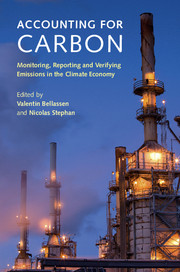Book contents
- Frontmatter
- Contents
- List of figures and map
- List of tables
- List of boxes
- Notes on contributors
- Acknowledgements
- 1 Introduction: key notions and trade-offs involved in MRVing emissions
- Part I MRV of territorial/jurisdictional emissions
- Part II MRV of industrial sites and entities
- 5 Trendsetter for companies and industrial sites: the EU Emissions Trading Scheme
- 6 Variant 1: the waste sector in Australia's Carbon Pricing Mechanism, another ETS at site level
- 7 Variant 2: non-site level emissions in an ETS–the case of electricity importers in the California cap-and-trade
- 8 Variant 3: emissions of a company/institution rather than a site: the case of the Shenzhen ETS
- 9 Variant 4: coexistence of voluntary and mandatory frameworks at the company level - Carbon Disclosure Project, EU ETS and French legal requirements
- 10 Direct measurement in the EU ETS
- Part III MRV at offset project scale
- Index
- References
10 - Direct measurement in the EU ETS
from Part II - MRV of industrial sites and entities
Published online by Cambridge University Press: 05 March 2015
- Frontmatter
- Contents
- List of figures and map
- List of tables
- List of boxes
- Notes on contributors
- Acknowledgements
- 1 Introduction: key notions and trade-offs involved in MRVing emissions
- Part I MRV of territorial/jurisdictional emissions
- Part II MRV of industrial sites and entities
- 5 Trendsetter for companies and industrial sites: the EU Emissions Trading Scheme
- 6 Variant 1: the waste sector in Australia's Carbon Pricing Mechanism, another ETS at site level
- 7 Variant 2: non-site level emissions in an ETS–the case of electricity importers in the California cap-and-trade
- 8 Variant 3: emissions of a company/institution rather than a site: the case of the Shenzhen ETS
- 9 Variant 4: coexistence of voluntary and mandatory frameworks at the company level - Carbon Disclosure Project, EU ETS and French legal requirements
- 10 Direct measurement in the EU ETS
- Part III MRV at offset project scale
- Index
- References
Summary
Context
GHG emission data are critical to international efforts to mitigate anthropogenic influence on the planet. The EU ETS (Emission Trading System) offers two methods for the determination of these emissions, a calculation and a direct measurement approach. Direct measurement is the monitoring of the mass emission of these compounds to air. The procedures, requirements and implications of each method have distinct differences. Chapter 5 emphasized the more commonly used “calculation approach” in this chapter we discuss the direct measurement method or measurement-based approach as it is more commonly referred to in the MRR (Monitoring and Reporting Regulation) of the EU ETS. Through its course we will answer some key questions:
• What are the main principles behind direct measurement?
• What are the selection criteria for direct measurement monitoring systems?
• What are the MRR requirements on direct measurement?
• What are the challenges of its implementation?
• What are the associated uncertainties?
• How does it compare against the calculation method?
The answers to these questions will allow the reader to understand the process behind the choice of a direct monitoring methodology and what needs to be considered in order for the method selected to be suitable to industry and individual installation characteristics. The direct measurement uncertainty requirements and if and how these can be adhered to, will also be discussed within the context of this chapter. Due to the nature of how the EU ETS operates the allowances from each installation are surrendered and traded at an absolute value and with no uncertainty attached to them. However, in order to facilitate fair trade stakeholders within the scheme need to be confident that the traded allowances are comparable within specified limits. It is there - fore essential that the initial reported GHG figures are determined with an uncertainty value associated with them and that this value is as low as practically possible depending on the size and emissions of each participating installation.
Information
- Type
- Chapter
- Information
- Accounting for CarbonMonitoring, Reporting and Verifying Emissions in the Climate Economy, pp. 313 - 338Publisher: Cambridge University PressPrint publication year: 2015
References
Accessibility standard: Unknown
Why this information is here
This section outlines the accessibility features of this content - including support for screen readers, full keyboard navigation and high-contrast display options. This may not be relevant for you.Accessibility Information
- 3
- Cited by
